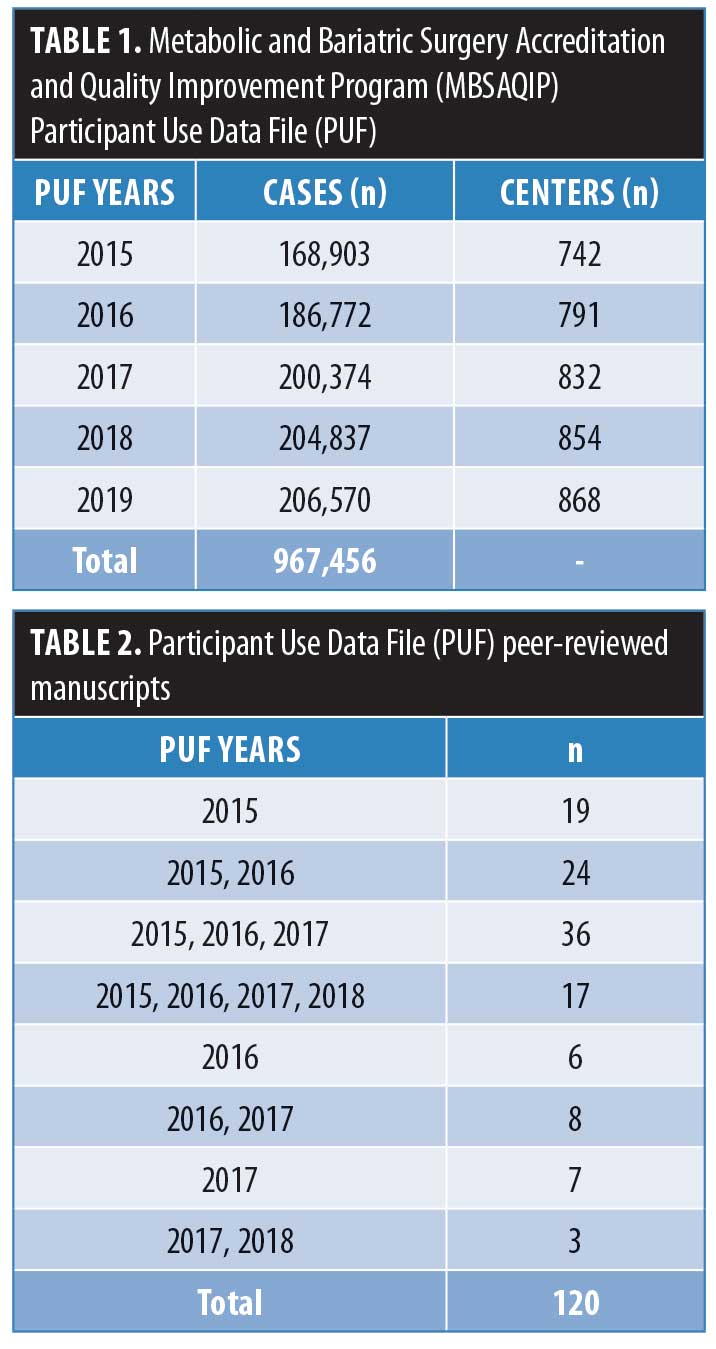Raising the Standard: Use of the MBSAQIP Participant Use Data File (PUF)
 by Anthony Petrick, MD, FACS, FASMBS; and Dominick Gadaleta, MD, FACS, FASMBS
by Anthony Petrick, MD, FACS, FASMBS; and Dominick Gadaleta, MD, FACS, FASMBS
Dr. Petrick is Chief Quality Officer, Geisinger Clinic; Director of Bariatric and Foregut Surgery, Geisinger Health System in Danville, Pennsylvania. Dr. Gadaleta is Chair, Department of Surgery, South Shore University Hospital; Director, Metabolic and Bariatric Surgery, North Shore and South Shore University Hospitals, Northwell Health, Manhasset, New York; Associate Professor of Surgery, Zucker School of Medicine at Hofstra/Northwell in Hempstead, New York.
FUNDING: No funding was provided for this article.
DISCLOSURES: The authors report no conflicts of interest relevant to the content of this article.
Bariatric Times. 2021;18(4):12
“In god we trust, all others must bring data.”
-W. Edwards Deming
In 2012, the American College of Surgeons (ACS) and the American Society for Metabolic and Bariatric Surgery (ASMBS) combined their respective national bariatric surgery accreditation programs into a unified program, creating a single national accreditation standard for bariatric surgery centers in the United States and Canada.1 Hallmarks of Metabolic and Bariatric Surgery Accreditation and Quality Improvement Program (MBSAQIP) include 1) center-based standards for the care of bariatric patients, 2) accreditation, 3) quality improvement, and 4) mandatory reporting of cases into the MBSAQIP Data Registry.
The Participant Use Data File (PUF) is a Health Insurance Portability and Accountability Act (HIPAA)-compliant data file containing cases submitted to the MBSAQIP Data Registry. The PUF contains patient-level, aggregate data. Its purpose is to provide researchers at participating sites with a data resource they can use to investigate and advance the quality of care delivered to the metabolic and bariatric surgical (MBS) patient through the analysis of cases captured by MBSAQIP.2
Any individual with an official role at an actively enrolled MBSAQIP center may request a copy of the PUF at https://www.facs.org/qualityprograms/mbsaqip/participant-use. Requestors must complete the MBSAQIP Participation Agreement, which also includes HIPAA data protections. The file is available in three different formats (text, SPSS, SAS). The PUF consists of five distinct datasets referred to as main, reoperation, readmission, intervention, and body mass index (BMI). MBSAQIP collects data on over 200 variables including preoperative risk factors, intraoperative variables, and 30-day postoperative mortality and morbidity outcomes for patients undergoing MBS procedures in both the inpatient and outpatient setting.
MBSAQIP training mechanisms ensure the highest quality data. Metabolic and Bariatric Surgical Clinical Reviewers (MBSCRs) are required to complete web-based training modules and pass an annual certification exam. MBSAQIP Clinical Support Registered Nurse (RN) Specialists are available to MBSCRs for data abstraction support and web-based training. Written educational resources are provided through the MBSAQIP Resource Portal.
All metabolic and bariatric surgical procedures and interventions performed by ANY provider in the accredited center must be entered into the MBSAQIP Registry. Cases are excluded if their procedures are done for cancer, trauma or if the patient is under 10 years of age. Additionally, cases are excluded if the 30-day follow-up rate is under 80 percent, the data integrity audit disagreement rate is over five percent, or the MBSCR(s) at the center do not successfully complete the annual MBSCR certification exam. Centers that have higher than a five percent data audit disagreement rate are not included in the MBSAQIP Semiannual Report and might be required to undertake additional training and audits.
There are several limitations to data in the MBSAQIP PUF. The database does not contain surgeon-specific, geographic, or center-specific identification. To maintain compliance with the Participation Agreement (PA) between the ACS and participating centers, facility identifiers and geographic information are removed. In accordance with HIPAA requirements, all absolute dates have been removed. The date of surgery is abridged to year of surgery only. Certain dates, including hospital admission, discharge and dates of laboratory tests, are recorded as durations. The PUF only contains 30-day outcomes. Many patients do not receive all possible preoperative laboratory tests, so some of these variables have a high percentage of missing values, which can make the use of these variables problematic in a traditional logistic regression model and other types of analysis.3
The MBSAQIP PUF is the largest, bariatric-specific, clinical dataset in the country. PUFs have been released for 2015 through 2019 reporting nearly one million MBS cases (Table 1). We anticipate that the COVID-19 pandemic will lead to the first decrease in case entry when the 2020 PUF is released. MBSAQIP extended case lock dates during the pandemic due to challenges faced by centers, including staff redeployment.

The MBSAQIP PUF has been a rich source of data for quality improvement and research since its first release. The 2019 PUF was only released in October 2020; however, an OVID search for publications using the 2015 to 2018 MBSAQIP PUFs as the data source identified 120 peer-reviewed manuscripts (Table 2). Multiple-year PUF data has been used in 73 percent of publications, with the largest number of publications using PUF data from 2015 to 2017. The primary objectives of the MBSAQIP PUF publications fall into the following categories:
- General MBS outcomes (n=8)
- Procedure-specific outcomes (n=22)
- Technique/technical (n=23)
- Prevalence of adverse events (n=23)
- Demographic group outcomes (n=17)
- Discharge disposition (n=5)
- Comorbidity outcomes (n=19)
- Miscellaneous (n=3)
Diabetes was the most common focus for comorbid outcomes (n=7). Overall. the topic that received the most attention was robotic-assisted bariatric surgery (n=22) in the technique/technical category. While both the ACS and ASMBS have been gratified by the use of the PUF to further the understanding of obesity and MBS, a concern has been publications that use the same data years yet report conflicting conclusions. These discrepancies are complex and might depend on exclusion criteria for cohorts, as well as variability in the definition of outcomes. We are currently performing a detailed review of all 120 publications using the PUF to identify opportunities to better assure the accuracy and integrity of published studies.
Readers may direct questions or comments about the Participant Use Data File to Rasa Krapikas at rkrapikas@facs.org.
References
- MBSAQIP. ASMBS. https://asmbs.org/about/mbsaqip. Accessed March 20, 2021.
- MBSAQIP Participant Use Data File (PUF). American College of Surgeons. https://www.facs.org/Quality-Programs/MBSAQIP/participant-use. Accessed March 20, 2021.
- User Guide for the 2019 Participant Use Data File (PUF). American College of Surgeons. https://www.facs.org/-/media/files/quality-programs/bariatric/mbsaqip_puf_userguide_2019.ashx. Accessed March 20, 2021.
Category: Past Articles, Raising the Standard




